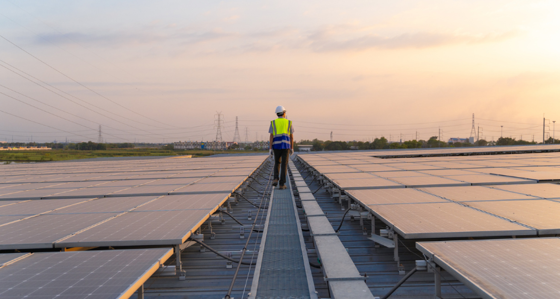
COP26 outcomes for the energy sector
16 November 2021
Now that the gavel has come down on the negotiations at COP26 in Glasgow, what does it mean for the energy sector? Here at Baringa, our global team of energy specialists have been providing advice to our clients on the energy transition for the past 20 years. Based on our experience, these are three key takeaways from the flurry of agreements and statements made over the past two weeks. Firstly exiting coal; secondly methane reduction targets, and thirdly on the establishment of a common rules for the global carbon markets.
Before turning to those, though, some reflections on the overall COP26 process and why we need to look at three separate agreements to understand the impacts on the energy sector. COP26 at Glasgow has been a continuation of the process of Nationally Determined Contributions (NDCs) begun at COP21 in Paris. The COP process has moved away from seeking to achieve a single, global commitment to reducing greenhouse gas emissions, which all countries must agree with, to a process where individual countries, or groups of aligned countries, make their own commitments and agreements, for example the US-China agreement. Different energy systems have different decarbonisation priorities, which makes international collaboration increasingly difficult, a trend which we expect to continue in future COPs. This partially explains why China and India on Saturday night requested last minute changes to “phase down” rather than “phase out” coal, bringing the Chair of COP26, Alok Sharma, close to tears. Understanding the impacts on the energy sector therefore requires looking at the other key agreements reached during COP
Global coal to clean power statement
Although excluding China and India, the statement was signed by 46 countries including new commitments from some of the world’s largest coal burning countries South Korea, Indonesia, Poland and Vietnam. Their commitments to cease issuance of new permits for new unabated coal-fired power generation projects sends a clear message to the energy sector that opens up new markets for low carbon wind and solar power generation.
We know that achieving industrial scale reductions in carbon emissions requires deployment of industrial scale amounts of low-cost wind and solar power generation. We also know how hard it is for countries to transition away from coal power, even for developed countries such as Germany who currently expect to continue to burn coal until 2038 and the US where passing the Infrastructure Bill is reliant on meeting the needs of politicians in coal producing states. Politicians in these less developed countries have been able to see that the economic benefits of coal exit outweigh the political costs of closure and ensuring a just energy transition.
By signalling their exit from coal, these countries have gained an advantage over others in the race to decarbonise their economies. For example, consumers will in the future be able to choose between products made in Coal-Powered China versus made in Renewable-Powered Vietnam.
We expect these new markets for wind and solar power generation to be boosted now that new coal generation is to be stopped. Demand for electricity grows at up to 7% annually in these countries, and that demand growth can now at least partially be met by renewable generation. Governments will be able to contract directly for this power by holding auctions which have driven costs down in many other markets. Alternatively, corporates seeking to decarbonise their operations in those countries will have more opportunities available to them to contract directly with renewable generators under corporate power purchase agreements, avoiding the need for government involvement entirely. The bottom line is that renewable energy developers should be actively looking to enter these new markets- if they are not already doing so- and look to begin the project development process.
Methane reduction targets
105 countries signed the Global Methane Pledge to reduce emissions 30 per cent by 2030, compared with 2020 levels. The US released a methane emissions reduction emissions plan. This included proposals for new funding including for plugging old oil and gas wells, new public-private partnerships for production of on-farm renewable energy from methane and increasing landfill gas capture and use. These new sources of revenue from investment in methane reduction in the US and potentially other countries will offer increased investment opportunities for the energy sector.
Carbon trading rules
The third key agreement for the energy sector was on the Article 6 rules for carbon trading. After six years of negotiation, there is now a common set of rules will make it easier for developers of carbon offsetting projects to be able to accredit and sell those credits globally. There has been a sharp increase in demand in recent years from companies and consumers seeking to reduce their carbon impact through offsetting. This new set of rules will allow the energy sector to access additional sources of revenue for carbon offsets, further incentivising carbon reduction.
Related Insights

What might a reformed GB national power market look like under REMA?
Discover how a reformed national market is likely to include significant changes to current market arrangements, with material impacts for market participants.
Read more
Investing in uncertainty: European power market outlook 2025
Our latest outlook points to a more uncertain energy transition, shaped by political and economic volatility across Europe in the form of Trade Wars, Populism and Remilitarisation.
Read more
REMA and investing in GB power market under uncertainty
Learn about the opportunities and challenges of investing in the GB power market under uncertainty and how Baringa can help
Read more
Three ways in which increased volatility and flexibility are reshaping Spain’s energy market
Spain's energy market faces profound change due to curtailment, negative prices, and a recent blackout, discussed at our roundtable event.
Read moreIs digital and AI delivering what your business needs?
Digital and AI can solve your toughest challenges and elevate your business performance. But success isn’t always straightforward. Where can you unlock opportunity? And what does it take to set the foundation for lasting success?